July-August 2024





































July-August 2024






































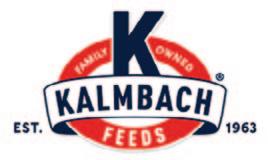
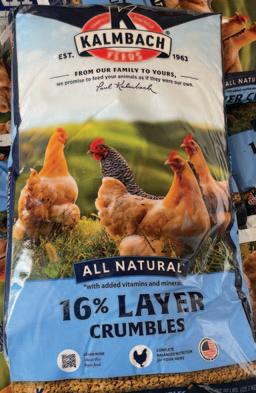


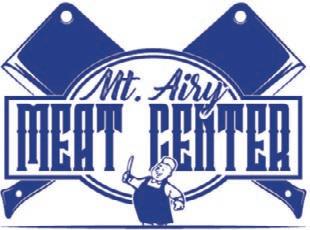






The AION outdoor mosquito repellant for backyard control combines a mixture of ingredients to protect your kids, dogs, and other pets from insects. Simply add water, and this mosquito barrier will provide the mosquito control you want.

“Eradicate Mosquitos” up to 90 days for only $19.99




















Anyone can provide advice. At Edward Jones, our goal is to provide advice and guidance tailored to your needs. That’s why we live and work in your community. When it comes to your financial needs and goals, we believe you deserve face-to-face attention.
You talk, we listen, and we get to know you.

SIPC For more information or to schedule a complimentary financial review, call or stop by today.
www.edwardjones.com
Paul J. Bunke, Sr., AAMS™, CFP®
Financial Advisor
124 W. Kapp Street, Suite C PO Box 407 Dobson, NC 27017
336-386-0846
paul.bunke@edwardjones.com
Audra Cox
Financial Advisor
715 S Main St, Suite B Dobson, NC 27017
336-569-7385 • 844-795-3462 audra.cox@edwardjones.com
Frank H. Beals
Financial Advisor
965 North Bridge Street Elkin, NC 28621
336-835-4411
frank.beals@edwardjones.com
Barry Revis, AAMS™ Financial Advisor
116 E. Market St., Elkin, NC 28621
336-835-1124
barry.revis@edwardjones.com
Nathan Sturgill
Financial Advisor
116 E Market Street Elkin, NC 28621
336-835-1124
nathan.sturgill@edwardjones.com
Aaron L. Misenheimer, CFP®, ChFC® Financial Advisor 1530 NC Hwy 67, Suite A Jonesville, NC 28642
336-258-2821
aaron.misenheimer@edwardjones.com
Andi Draughn Schnuck
Financial Advisor
496 N. Main Street Mount Airy, NC 27030
336-789-1707
andi.schnuck@edwardjones.com
Dale Draughn, AAMS™ Financial Advisor 140 Franklin Street Mount Airy, NC 27030 336-789-0136
dale.draughn@edwardjones.com
Logan Draughn
Financial Advisor
492 N. Main Street Mount Airy, NC 27030
336-789-3323
logan.draughn@edwardjones.com
Kody Easter, AAMS™, CRPC™, CFP®
Financial Advisor
304 East Independence Blvd Mount Airy, NC 27030
336-789-2079
kody.easter@edwardjones.com
Randy D. Joyce
Financial Advisor
136 W. Lebanon Street Mount Airy, NC 27030 336-789-6238
randy.joyce@edwardjones.com
Tammy H. Joyce, AAMS™ Financial Advisor
136 W. Lebanon Street, Mount Airy, NC 27030 336-789-6238
tammy.joyce@edwardjones.com
Tanner Joyce
Financial Advisor
752 S. Andy Griffith Parkway, Suite 400 Mount Airy, NC 27030 336-245-9112
tanner.joyce@edwardjones.com
Mike Russell
Financial Advisor
106-B South Depot Street, Pilot Mountain, NC 27041 336-368-2575
mike.t.russell@edwardjones.com
Michael Warren
Financial Advisor
101-D Shoals Road, Pilot Mountain, NC 27041
336-368-0782
michael.warren@edwardjones.com
Christopher L. Funk
Financial Advisor
128 South State Street • PO Box 790 Yadkinville, NC 27055 • 336-679-2192
chris.funk@edwardjones.com

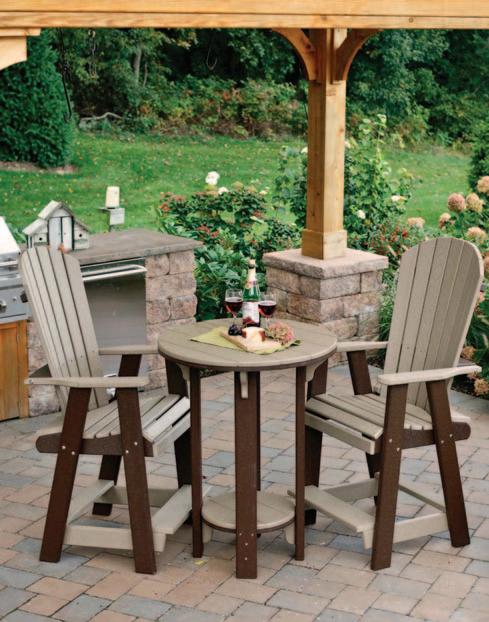




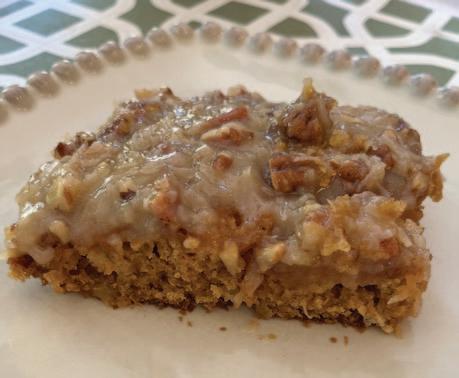






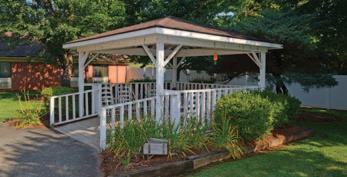




At Yadkin Valley Magazine we value the concerns, ideas and interests of our readers. We welcome all story ideas and suggestions, always keeping an open file and working them in when possible. All story ideas should be submitted by mail to: PO Box 2077, Yadkinville, NC 27055.
Please submit information regarding fundraisers, gallery show openings, plays, readings, concerts or other performances at least two months in advance of an issue’s cover date. Sign up for our free weekly newsletter yadkinvalleyweekends.com/weekends
The magazine is FREE at locations throughout the Yadkin Valley. You will find a highlight listing of pick-up locations on our web site at www.yadkinvalleymagazine.com. Not all locations will always have copies in stock.
We view our advertisers as people providing a service or a product who are genuinely interested in their customers. These businesses make it possible for you to enjoy the magazine for free. We hope that you’ll make them your first choice when you need the products and services they offer. Be sure to share that you read about them in Yadkin Valley Magazine.
Information about advertising is available at: yadkinvalleymagazine.com/advertising
Health and educational articles included in Yadkin Valley Magazine are for information purposes only. Be sure to consult your personal physician before you begin any diet, medicine or course of treatment.
Yadkin Valley Magazine
Yadkinville, NC 27055
336-961-2620
July-August 2024
Volume 24 Number 6
PUBLISHER
Leah Wagoner Williams
ASSISTANT EDITORS
Victoria Williams
Rebecca Williams
ADVERTISING SALES
Leah Wagoner Williams
Ken & Denise Knight
CONTRIBUTING WRITERS
Lynn Duty
Peggy Isenhour
Chelsea Johnson
Molly Johnson
Madaline Jones
Dr. Heather Kilbourne
Ashley Lauer
Carmen Long
Derek Morris
Sharee Parker
Kellee Payne
Lisa Prince
June Rollins
Jessica Wall
Jill Walker
PHOTOGRAPHS & PHOTOGRAPHERS
Amber Harris
Peggy Isenhour
Chelsea Johnson
Molly Johnson
Madaline Jones
Carmen Long
Derek Morris
Sharee Parker
Kellee Payne
Lisa Prince
June Rollins
Leah Williams
Rebecca Williams
DISTRIBUTION
Amber Harris
Ken & Denise Knight
Michael Scott
David Williams
Isaac Williams
Mark Williams
Bailey Williams




Lesson learned...don’t put a cake on the cover of Yadkin Valley Magazine and not include the recipe. So, better late than never, you can find the recipe for the strawberry cake from the May-June cover at yadkinvalleymagazine.com. Local strawberries may be gone, but peaches will be here soon and I think they are pretty good on cake, too. You can find the recipe for the vanilla ice cream on this issue’s cover below. Recently, I had a chance to visit some parts of the country that I had never seen before. As we were driving and saw beautiful and unfamiliar sights, I pointed them out and often took a photo or video. I thought of the locals who got to see those same sights every day, and might not appreciate them, at least not the way I did, seeing them for the first time.
But at home in the Yadkin Valley, I am sure I am guilty of the same thing. We may not have any Badlands, or the stark landscape of southern Wyoming, or jagged peaks like eastern Nevada, but we have some pretty fantastic sights that I know I take for granted. Maybe your travels this summer will give you a peek at new places, but if you are staying closer to home, don’t forget that we have some pretty incredible landscapes, too. You can find some daytrip suggestions in this issue if you need some suggestions. If you are lucky enough to have a Cooperative Extension Homemaker’s Cookbook, you know you have a treasure. My copy from the Yadkin County Extension Homemakers Club was a wedding gift, and the last one published. My mom has some older cookbooks with recipes contributed by my grandmother when she was a member. Read about the legacy of the Extension Homemaker’s Cookbooks in Surry County. It’s in the recipe section, but is a perfect Yadkin Valley Heritage story, too.
The first official day of summer is still a few days away as I finalize this issue. I am sure that I will grumble and complain about the heat and humitdity before summer is over, but for the moment I am enjoying the long days. Lightning bugs, planting flowers and vegetables, and even mowing the yard are some of my favorite things. May each of you enjoy your summer, too, or at least keep the air conditioner running smoothly!
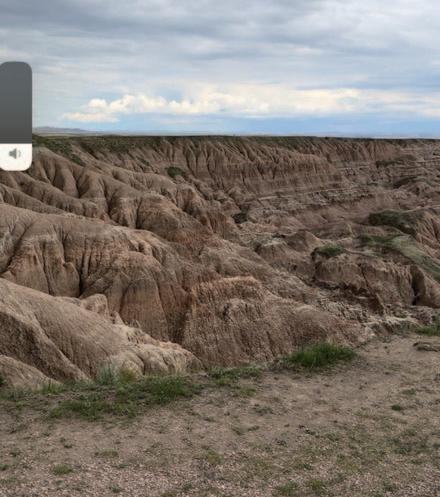

1 can sweetened condensed milk
1 pint whipping cream
1/2 to 3/4 cup of sugar (or to taste)
3-4 teaspoons vanilla
milk to finish filling the container
Mix the first four ingredients. You can do it rignt in the canister, but for fluffier ice cream mix in a blender, with a hand mixer, or with an immersion blender. Finish filling the canister with milk and freeze. If you want to add fruit, cut back on the vanilla.
Our telephone number is 336-961-2620 web address: yadkinvalleymagazine.com
Please email the following: Advertising Inquiries Weekends/Events Calendar Submissions
BEST Yadkin Valley COOKS recipes Pet Photos to: yadkinvalleymagazine@gmail.com


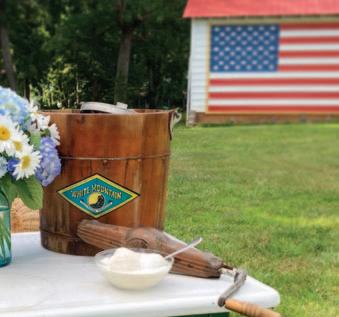
Yadkin Valley Magazine assumes no responsibility for unsolicited materials. Entire contents copyright 2024 All rights reserved. Reproduction of our created advertising materials and design work are strictly prohibited. Yadkin Valley Living, Yadkin Valley Magazine, Yadkin Valley Weekends, Best Yadkin Valley Cooks, 52 Pounds and then some!, are trademarks of Crossroads Publishing LLC, PO Box 2077, Yadkinville, NC 27055.
Proudly printed in the USA. Every effort has been made to ensure the accuracy of the information contained in the magazine. We assume no responsibility for changes in schedules, prices, hours or information.
Before travelling long distances, it is always wise to use the contact numbers included in the magazine to confirm that the events you wish to enjoy are still on schedule.
The contents of advertising and articles do not necessarily represent the views of the publisher. The publishers assume no responsibility for errors or omissions of any advertisement beyond the actual cost of the advertisement. In no event shall the publishers be liable for any consequenstial damage or any damages in excess of the cost of the advertisement.
Before you replace the wood on your deck, talk to us about…DECK RESTORE™ or DECK REVIVE products. Both products revive and protect wood surfaces such as wood and composite decking, stairs, docks and more. They install at a fraction of the cost of total surface replacement while adding years of life to older wood decks!
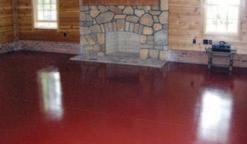
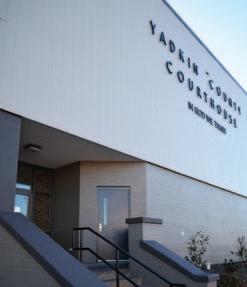

Our Design Specialist can offer creative ideas on any painting project. Whether you’re just needing a little guidance… or the whole idea.
Want to see more before & after samples of our work? Call me today and I’ll be glad to bring photos by for you to see. Discover how our superior protective coatings stand up to the toughest elements Mother Nature can throw at it. How much will it cost? My consultation visit and estimate are FREE. —Mark Diachenko. Mark@PaintandCoatingsLTD.com






Visit June’s website at: www.junerollins.com

Thirty years ago, before I began painting, I loved nature photography. Many hours were spent wandering around outdoors with my 35mm. I especially loved macro photography. Exploring the environment up close was time altering.
A desire to paint from my photos eventually surfaced and my journey as a painter began twenty-four years ago in my mid-forties. I am as captivated now as I was then.
A couple of summers ago, surrounded by sunflowers, I gathered photo references for future paintings. Back home, studying the images closer, I noticed something I hadn’t noticed earlier, a tiny subject I knew would be my center of interest. As I painted, I imagined what it would be like to be a ladybug in a sunflower world.
This past April, I planted twenty-five sunflower seeds along a fence line in our front yard. As I’m writing this column in early May, emerging seedlings are filling me with awe and anticipation, not only for the promise of sun flowers, but for an approaching new chapter in my life. I’m retiring the end of August.
Retirement to me is having more time to do what I love. More time at home with Rob and Rosie. More time to reflect, write, walk, try new recipes, flower garden, read, paint, and play. More time for walking on sunshine.
Enjoying the journey,
June



& PHOTOS
Chelsea Johnson
Family and Consumer Agent
N.C. Cooperative Extension Yadkin County Cooperative Extension
Summertime is the perfect season for enjoying fresh and vibrant salsa.
Whether you're hosting a backyard barbecue or simply looking for a refreshing snack, salsa is a versatile and delicious option. With the abundance of ripe tomatoes, crisp bell peppers, and spicy jalapeños available during the summer months, you can create a variety of salsas to suit your taste.
Incorporating seasonal fruits like mangoes, pineapples, or peaches can add a sweet and tangy twist to traditional salsa recipes.
Additionally, including fresh herbs like cilantro and mint can enhance the flavors and provide a cooling effect, making your salsa a hit at any summer gathering.
Remember to pair your summertime salsa with crispy tortilla chips, use it as a topping for grilled meats or fish, or even serve it alongside tacos or quesadillas for a burst of flavor. The possibilities are endless when it comes to enjoying salsa during the summer!
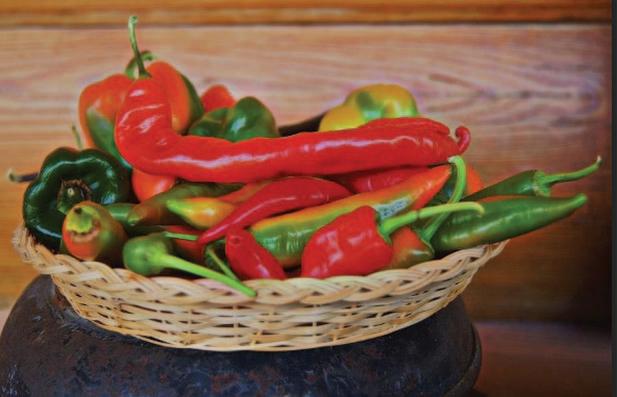
Canning salsa is a great way to preserve the flavors of fresh summer produce to enjoy throughout the year. When canning salsa, it's important to follow a reliable recipe that has been tested for safety to ensure that the salsa is properly preserved.
Here are some general steps to keep in mind when canning salsa:
1. Start with fresh, high-quality ingredients, including ripe tomatoes, onions, peppers, and any other vegetables or fruits you want to include in your salsa.
2. Prepare the salsa according to a trusted canning recipe, making sure to follow the instructions for proper sterilization of jars and lids.
3. Use a water bath canner to process the filled and sealed jars of salsa. This involvessubmerging the jars in
boiling water for a specific amount of time to kill any bacteria and create a vacuum seal.
4. Allow the processed jars to cool and check that the lids have sealed properly. Store the sealed jars in a cool, dark place for long-term storage.
It's important to note that acidity is a key factor in safe canning, so it's crucial to use a recipe that has been specifically developed for canning, as the acidity level of the salsa needs to be at a safe level to prevent the growth of harmful bacteria.
By following proper canning procedures and using tested recipes, you can safely and deliciously preserve the flavors of summer in your homemade salsa for enjoyment throughout the year.
Serves 6
Serving Size: ¾ cup
Prep Time: 20 minutes
Total Time: 20 minutes
Ingredients:
4 navel oranges, peeling and white removed, chopped
½ cup chopped cucumber
½ cup diced daikon or jicama (optional)
2 teaspoons finely chopped jalapeños
1 tablespoon finely grated fresh ginger
Juice from 1 lime
1 tablespoon brown sugar (to taste – optional)
Fresh mint, cilantro, or parsley, finely chopped (to taste – optional)
Directions
1. Combine all ingredients in a large bowl and refrigerate.

Serves 6
Serving Size: 1 cup
Prep Time: 5 minutes
Cook Time: 5 minutes
Chill Time: 10 minutes
Total time: 20 minutes
Ingredients
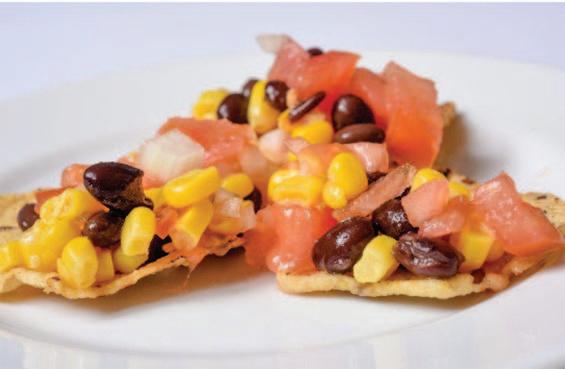
1 (15-ounce) bag of frozen white corn (or white and yellow mixed)
1 (15-ounce) can black beans, rinsed and drained
2 cups chopped tomatoes
½ cup chopped Vidalia onion
1/3 cup apple cider vinegar
1/3 cup extra virgin olive oil
Salt and pepper to taste
Directions
1. Cook the frozen corn according to package directions and chill.
2. Combine all ingredients in a large bowl.
3. Serve immediately (with chips, or as a condiment), or chill until serving.
Source: Med instead of Meds
Lisa Prince
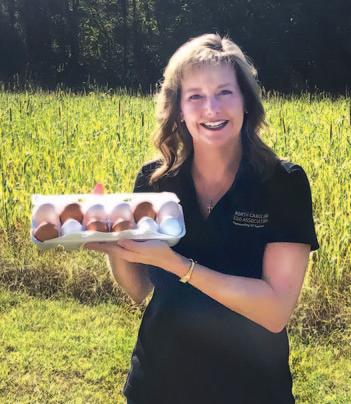
Lisa Prince, Director, NC Egg Association
Practicing healthy habits—including eating a nutritious diet—can reduce the risk of heart disease-related issues. In fact, research shows that at least 75% of heart disease can be prevented through lifestyle changes! And, did you know that eggs can be included as part of a heart-healthy diet for healthy adults, according to the American Heart Association?
Get four tips for developing and following a heart-healthy eating pattern.
Rule #1: Integrate lean protein into meals.
Rule #2: Use as little added salt as possible to flavor food.
Rule #3: Eat enough fruit and vegetables. Whether fresh, frozen, or canned (no-salt-added, preferably).
Rule #4: Add in foods that are high in potassium, magnesium, calcium, and vitamin C.
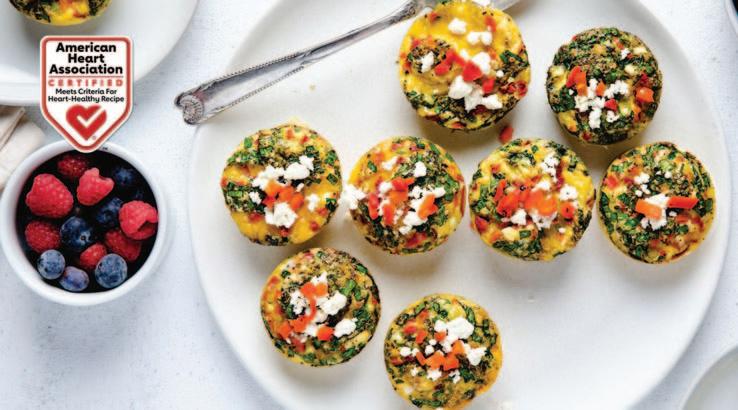
https://ncegg.org/recipes/veggie-loaded-egg-muffins/
Prep Time: 5 minutes
Cook Time: 25 minutes
Servings: 12
2 jarred roasted bell peppers, about 4-oz plus extra for garnish.
1 green onion
2 cups baby spinach
1/2 cup crumbled reduced-fat feta cheese
12 large eggs
1/4 cups low-fat milk
1 tsp Italian seasoning
1/2 tsp kosher salt
1/4 tsp ground black pepper
1. Preheat oven to 350 degrees. Spray the cups of a 12-cup muffin pan generously with non-stick cooking spray.
2. Finely chop roasted red bell pepper, green onion, and spinach; divide evenly among muffin cups. Top with feta cheese.
3. Whisk eggs with milk, Italian seasoning, salt, and pepper in a large bowl.
4. Pour egg mixture evenly among muffin cups and bake until eggs are set, about 22-25 minutes.
5. Cool in muffin time for 5 minutes before removing.
NOTE: Be sure to coat muffin pan cups thoroughly so that eggs can easily be removed. A toothpick can be used around the edges to help release them from the tin. A silicone muffin pan can be useful here too, but you’ll still need to coat the cups with non-stick cooking spray.
https://ncegg.org/recipes/roasted-vegetable-grain-bowl/
Prep Time: 10 minutes
Cook Time: 1 hour 10 minutes
Servings: 4
2 cups of water
1 cup of farro, rinsed
1 medium sweet potato, cut into 1/2-inch cubes
1 small red onion, cut into 1/2-inch pieces
1 zucchini, cut into 1/2-inch cubes
1 yellow squash, cut into 1/2-inch cubes
1 tbsp extra-virgin olive oil
1/4 tsp kosher salt
1/8 tsp ground black pepper
1 can (15-oz) no-salt-added kidney beans, drained and rinsed
4 large eggs
1/4 cups nonfat plain Greek yogurt
2 tbsp low-fat buttermilk
1 clove garlic
1/4 cup fresh chives roughly chopped
1/4 cup fresh parsley roughly chopped
4 1/2 cup of baby spinach
2 tbsp fresh tarragon leaves
1/8 tsp kosher salt
Preheat oven to 450 degrees and line a large, rimmed baking sheet with foil. Place it in the oven while it preheats.
For the Farro: Bring water to a boil in a medium saucepan. Add farro and reduce heat to a simmer. Cover and cook until tender, about 20 to 25 minutes. Drain, then rinse with cold water to cool.
For the Vegetables: Meanwhile, toss sweet potato, onion, zucchini, and squash with oil, salt, and black pepper. Remove the baking sheet from the oven and coat generously with non-stick cooking spray. Spread vegetables out evenly onto the prepared baking sheet. Roast, stirring once halfway through cooking time, until vegetables are fork-tender, about 30 minutes. Remove baking sheet from the oven, add the kidney beans, and stir to combine. Return the baking sheet to the oven and cook for an additional 5 minutes.
For the Dressing: Add the yogurt, buttermilk, garlic, chives, parsley, spinach, tarragon, and salt to the bowl of a small food processor. Blend, scraping down the sides as needed, until smooth. Transfer to a bowl then cover and refrigerate until ready to use.
For the Eggs: Bring a small saucepan of water to a simmer over medium-high heat. Use a spoon to gently drop eggs into water; cook for 8 minutes. Drain carefully using a slotted spoon and place eggs in an ice bath to stop the cooking process. Once cooled, peel and slice the eggs in half.
For the Bowls: To serve, drizzle farro and spinach among serving bowls. Toss vegetables and beans with 1 tablespoon dressing and distribute among bowls. Top with eggs and drizzle bowls with remaining dressing.



ShaRee H. Parker
ShaRee H. Parker
Crust:
1 ½ cups sweetened shredded coconut
1 cup all-purpose flour
1 cup brown sugar
½ cup butter, melted
½ cup chopped pecans

Combine all ingredients in a bowl and stir until well combined. Press ½ of the mixture (approximately 1 ½ cups) into a 9-inch square baking pan that has been sprayed with cooking spray, such as Pam. Set remaining mixture aside for topping.
Filling:
½ cup granulated sugar
3 Tablespoons cornstarch
1. 20 ounce can crushed pineapple, undrained
1 Tablespoon fresh lemon juice
1 Tablespoon butter, melted
1 teaspoon vanilla extract
1 teaspoon coconut extract
2 Tablespoons coconut rum
Combine all the filling ingredients in a 2-quart glass batter bowl and stir until combined. Microwave on high at 2-minute intervals until thick and bubbly, approximately 4-6 minutes. Cool slightly. Spread over crust. Sprinkle with the reserved crust topping.
Bake in a preheated oven at 350 degrees for approximately 30 minutes or until golden brown. Serve warm. Garnish with whipped cream and maraschino cherries, if desired. Refrigerate leftovers.
I love coconut, especially paired with pineapple and pecans!


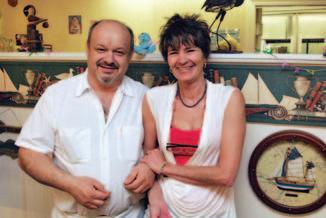




July and August bring us the dog days of summer. I am thankful for air conditioning! As a child, we did not have air conditioning, so cooking was done in the middle of the day. We kept windows open along with doors because our outside doors had screens. Fans, electric and hand held, were used throughout the day with an overhead attic fan to cool us at night.
In July, we think about celebrating the 4th of July. We were always at the beach for a big family vacation during the week of July 4th. I grew up in a mill town, and the mills were always closed for the week. My dad was a self-employed barber, so he thought since the mills were closed, he would not be busy so we headed to the beach. We enjoyed lots of home cooked food with aunts, uncles and cousins. The 4th of July fireworks on the beach were a special occasion we always anticipated.
August brings thoughts of a new school year. Teachers and students wonder how the summer disappeared so quickly. Students are anxiously awaiting a new school year, but are not ready to give up sleeping later and their days at the pool with friends.
This month’s recipes are God Bless America cake, Easy Sloppy Joe’s, and Cherry Whip Salad. The cake is not red, white, and blue like a patriotic cake. The cake received its name from the original owner baking the cake, and her husband took one bite and said “God Bless America!” It has a coconut pecan icing that is so rich and delicious. If you are cooking gluten free, the only change would be to substitute gluten free flour for the regular flour. I have included in parentheses the brand that I use and recommend. Easy Sloppy Joes is a recipe I have been using for over thirty years. It is very simple and uses ingredients that I keep on hand. Most grocery stores carry gluten free hamburger buns to use instead of buns with wheat. The Cherry Whip Salad is so light and delicious during these warm summer months. It is simple and quick to put together and keeps in the refrigerator for many days. It is naturally gluten free. Stay cool! Fall is around the corner. Blessings
2 cups all-purpose flour (I use King Arthur Measure for Measure Gluten Free flour)
2 teaspoons baking soda
½ teaspoon salt
2 eggs
¼ cup vegetable oil
1 20 oz can crushed pineapple, with juice
1 cup white sugar
½ cup brown sugar
1 12 oz can evaporated milk, not condensed milk
1 cup (2 sticks) butter
1 ½ cups white sugar
¼ teaspoon salt
1 teaspoon vanilla
2 cups sweetened, flaked coconut
1 cup chopped pecans
Grease a 9x13 pan; set aside. Mix together flour, baking soda and salt. Set aside. Cream together eggs, vegetable oil, pineapple with juice, white and brown sugar. Stir in flour mixture until all ingredients are well combined. If cooking gluten free, let batter sit for 20 minutes, stir and then proceed with following directions. Pour batter into baking pan and bake at 350 degrees for 25-30 minutes or until golden brown and toothpick inserted in middle comes out clean. While cake is baking, prepare the icing. Heat evaporated milk, butter, sugar and salt in a medium saucepan over medium-high heat until boiling, stirring frequently. The milk mixture will bubble up a lot, so do not use a pot that is small. Reduce heat to medium and boil mixture for 10 minutes or until a caramel color and thickened, stirring occasionally. Remove from heat and stir in vanilla, coconut and pecans. Let icing cool 5 minutes and then spread over warm cake. Rest cake, uncovered 2 hours before serving. Cake does not need to be refrigerated. Cake also freezes well.













1 ½ lbs ground beef
1 onion chopped
1 teaspoon salt
1/8 teaspoon pepper
3 tablespoons flour (I recommend King Arthur Gluten Free Measure for Measure flour)
1 tablespoon Worcestershire sauce (Lea & Perrins is naturally gluten free)
1 cup ketchup
1 ¼ cup water
Brown beef and onion; drain; stir in other ingredients; simmer 20 minutes. Serve with hamburger buns (I use Schar gluten free hamburger buns at Walmart or Trader Joe’s gluten free hamburger buns).
14 oz Eagle Brand milk
8 oz Cool Whip
11 oz can mandarin oranges
8 oz crushed pineapple, drained
2 cups miniature marshmallows
21 oz cherry pie filling
½ cup chopped pecans
Fold together Eagle Brand milk and Cool Whip. Then fold in other ingredients. Be gentle folding in fruits. Refrigerate at least 2 hours.











with Kathy Gray

On the Family Recipe page, I will share some favorites from our family and those who are like family. My Aunt Kathy makes many tasty dishes, but sheshared this recipe because she knows it is one of my favorites!
1/2 cup to one cup of coarse chopped pecans; toasted in a small pat of butter. Be careful not to burn!
1 small package of instant French vanilla pudding mix (butterscotch is good too, but hard to find!)
16 ounces of either whipping cream or whipped topping
1 1/4 cup of sugar
1 can of sweetened condensed milk
1 tsp vanilla whole milk-enough to finish filling the canister
Mix all of the ingredients together and pour into ice cream freezer. Finish filling the canister with whole milk (there should be a fill line!)

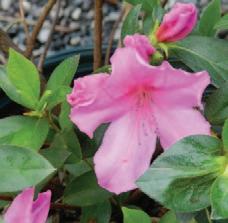
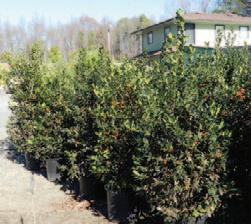





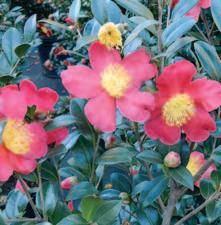
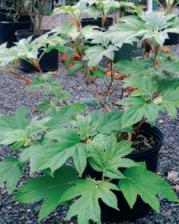



Carmen Long

WRITER & PHOTOS
Carmen Long
Family and Consumer Agent
N.C. Cooperative Extension
Ask many people in Surry County what is their most used cookbook, and a common response may be, “the red one.” For more than 50 years, Surry County residents have been making their family favorite recipes from the red Extension Homemaker cookbook. The original hardbound red book published in 1968, contains over 650 recipes compiled by local club members, along with helpful cooking tips, basic kitchen information, stain removal and a first aid guide. The red cookbook was the answer source before the internet. So popular, the Red Cookbook Favorite Recipes Volume II was published in 1988, followed by Favorite Recipes Volume I, Revised in 1992 and Favorite Recipes…A Second Helping in 2001.
All four of the cookbooks are out of print, but we still have frequent phone calls to the Extension Office from someone who would like to give one as a wedding present or to a family member. Sometimes you may be lucky and find one of the used and loved books at a yard sale or auction.
I recently had someone tell me they had received their grandmother’s cookbook complete with her handwritten notes along the sides from an aunt. You would have thought the recipient had won the lottery.
Many of us enjoy reading cookbooks like we would read a novel. In community cookbooks tell local history. It is interesting to see the names of the contributors and types of recipes submitted. In the original cookbooks members often used their husband’s first name followed by their name in parentheses – which we don’t often see in 2024. Example: Mrs. Brent (Carmen) Long. I have worked and lived in Surry County for 20 years and had the privilege of knowing many of the wonderful cooks who contributed recipes. Others I may not have known personally but have heard stories about them or know someone in their family. Extension Homemakers changed their name to Extension and Community Association (ECA) in the 1999. Many of the organization’s original goals remain the same. ECA is a volunteer organization designed to improve the quality of life in homes and communities through educational programs and leadership development.
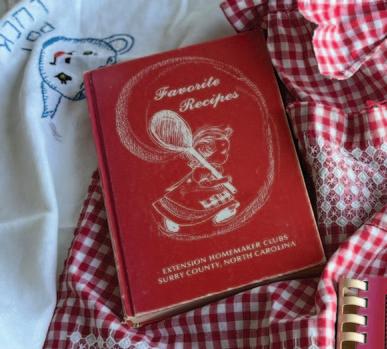
In Surry County we have three Extension and Community Association clubs that meet monthly.
Siloam ECA Club meets the 2nd Monday of each month at 12:00 noon at Siloam Baptist Church. Beulah ECA Club meets the 3rd Tuesday of each month at 7:00 pm at the Beulah Community Center. Pilot Mountain Achievers ECA Club meets on different days and times based on their monthly program.
ECA clubs welcome new members. If you would like to start a new club in your community, form a special interest club around a particular topic, or for more information about an existing club, please contact the Surry County Center of North Carolina Cooperative Extension at 336-401-8025.
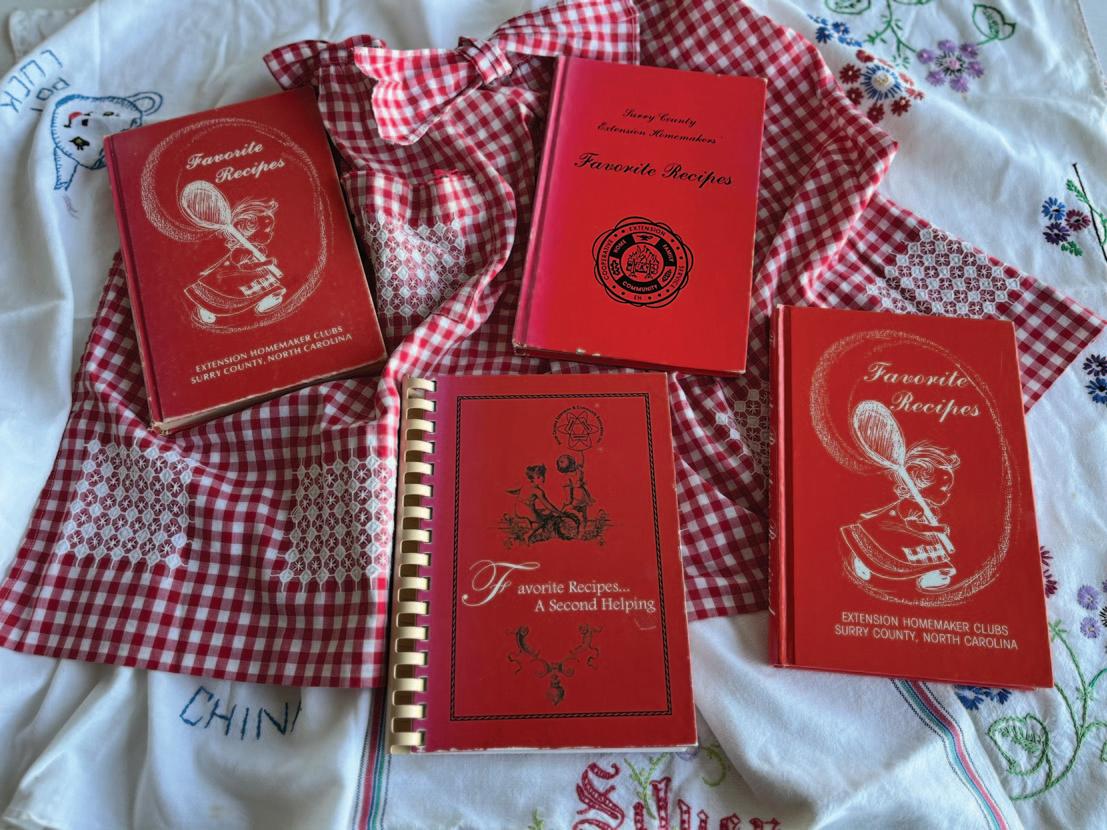
Enjoy this no-bake dessert from the original Red Cookbook, perfect for a crowd on a hot summer day.
Ingredients:
1 (3oz) package lemon flavored gelatin
1 cup boiling water
1 Tablespoon lemon juice
1 (8 oz) pkg. cream cheese
1 cup sugar
1 teaspoon vanilla
1 (13 oz) can evaporated milk, well chilled
3 cups graham cracker crumbs
½ cup butter, melted
Directions:
Dissolve gelatin in boiling water. Add lemon juice and cool. Cream together cream cheese, sugar, and vanilla. Add gelatin mixture and mix well. Whip evaporated milk until thick and fold into gelatin mixture. Mix melted butter with graham cracker crumbs and pack two-thirds of the mixture on the bottom and sides of a 9 x 11-inch pan. Pour filling into the cracker lined pan and spread evenly with spatula. Sprinkle top with remaining one-third of the graham cracker crumbs. Refrigerate and cut into squares to serve.
Submitted by Mrs. Tom Inman and Mrs. Joe D. Carson


Kellee Payne
Kellee Payne
Commercial and Consumer Horticulture Agent
N.C. Cooperative Extension Yadkin County Center
kellee_payne@ncsu.edu
Facebook @YadkinCountyHorticulture


According to NC State Extension Tourism, Agritourism is defined as “a form of consumer engagement where farms “offer a variety of recreational, educational, and tourism activities to make their finances more resilient.” To promote agritourism in North Carolina, The Visit NC Farms App was launched in 2018 as a pilot program developed by a marketing team at the North Carolina Department of Agriculture and Consumer Services. The app is funded by the NC Tobacco Trust Fund Commission, Specialty Crop Block Grant, and NC Sea Grant. The app is designed to connect visitors and residents across the State to local farms & fisheries, local food & drink, farmers markets, pick your own, local shops, farm stays & lodging, itineraries & trips, and special agricultural events.The app is a mobile tool available on Apple and Android devices to give users full access to information that can connect them to the closest farm or activity that interests them. Today, 81 out of 100 North Carolina counties are active in the app highlighting everything NC has to offer and making a huge impact. From the sea to the mountains, and everything in between, visitors and residents have the opportunity to get the real Agriculture experiences that have characterized NC for years.
Whether you are looking for a day trip in your home county or something to do while vacationing across the state, the Visit NC Farms App is an excellent tool that is accessible on your smartphone. Yadkin County is a featured county on the app with a variety of assets listed. In the county, you can explore pick-your-own operations, vineyards and wineries, shopping local, venues, farm stays, and much more. The partnership would not be possible without the help from our sponsors: Yadkin County Farm Bureau, Yadkin County Visitor Center, Jonesville Tourism Development Authority, and Alpha and Omega Corn Maze.
Go ahead, download the app and check it out for yourself! The opportunities are endless!
1. Download the Visit NC Farms app for free on the Apple App Store or the Google Play Store.
2. Once downloaded, choose which region you want to receive push notifications from: Mountains, Piedmont, or Coastal. You can also select one or all three and it can be changed at any point.
3. Start searching! Have fun exploring the opportunities across the state of North Carolina!
Our office is an equal opportunity provider, so if you have any questions related to the Visit NC Farms app or horticulture questions, please contact Kellee Payne at kellee_payne@ncsu.edu or 336-849-7908.
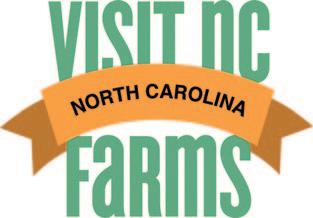


Derek Morris
Derek Morris
Horticulture Technician
N.C. Cooperative Extension Forsyth County Center
The pawpaw is the largest edible tree fruit native to North America and not only is it native to most of North Carolina but also to 25 other states mostly in the east and south. It is found in northern parts of Florida into the southern tip of Ontario Canada and as far west as eastern Texas and into Kansas. What makes this so remarkable is that the pawpaw, botanically known as Asimina triloba, is a member of a large family that is almost exclusively confined to the tropics from Africa to Asia with the majority hailing from central and South America. Many commonly eaten fruits in tropical countries such as guanabana, cherimoya, and sweetsop are among its relatives. The ylang
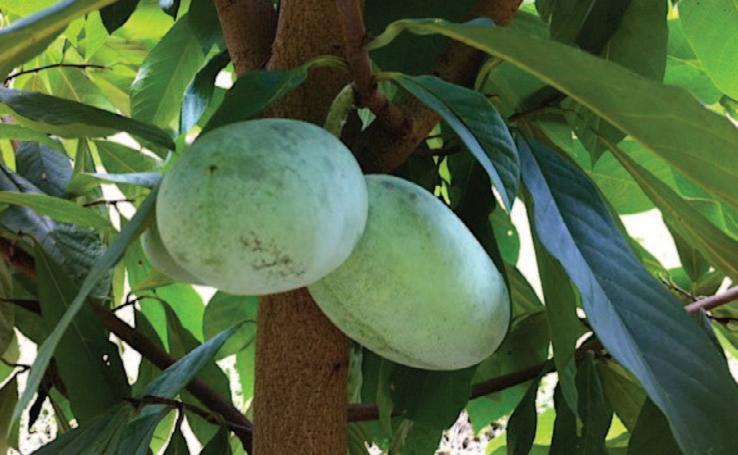
ylang tree is another relative that is grown on a commercial scale for its fragrant blossoms used in the perfume industry. Anyone who has ever been near this tree when it is in full bloom will never forget the experience. The pawpaw has a long history and was relished by native Americans long before any European settlers arrived, mainly for its delectable fruits, but rope and twine and other items were made with the inner bark and the ground seeds were known to have insecticidal properties which were utilized by some.
Early European settlers quickly learned about and gathered pawpaw fruit in late summer and early fall when they were ripe. It is said that one of
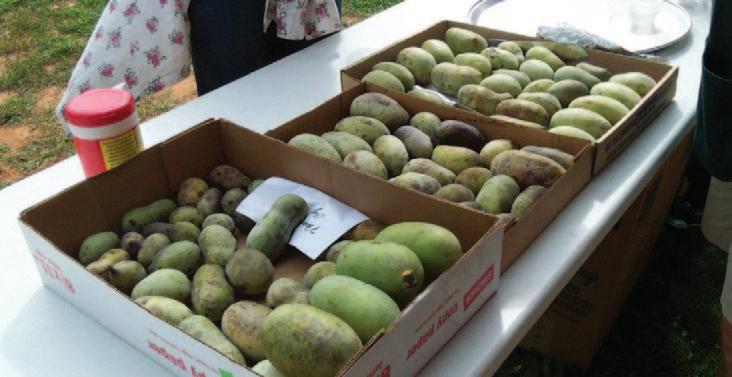
George Washington's favorite desserts was chilled pawpaw and Thomas Jefferson was known to be fond of the fruit. Pawpaw trees can still be found growing today at both Mount Vernon and Monticello. Daniel Boone and Mark Twain can also be counted as among pawpaw fans. It is written in the journals of the Lewis and Clark expedition that they subsisted on pawpaws and biscuits on their last days returning.
Pawpaw never entered the larger marketplace as did other American natives such as blueberries and pecans. One major reason for this is that the pawpaw fruit when ripe is highly perishable and does not travel well. The fruit generally has a short shelf life of about 3-4 days at room temperature once harvested from the tree, however they can store somewhat longer in refrigeration. The pawpaw tree is an exceptional fruit tree for the backyard grower as it has relatively few problems and does not require spraying. The tree fruits best planted in full sun but grows very well in a more shaded area and in most cases shaded areas are generally where one finds them growing in the wild. There are upwards of 60 named cultivars available today and at least two different clones or cultivars

are needed for cross pollination if you are after fruit. The tree planted in a mostly sunny area generally grows between 15 and 20 foot tall with a 10 to 15 foot spread. Some growers with limited space successfully keep their trees at 8 foot tall by summer pruning and planted as close as 6 foot apart. The rather large attractive leaves which can be up to a foot long turn butter yellow in the autumn before dropping. Pawpaw usually starts blooming in our area in April. The inch wide blooms start out green and morph to a dark burgundy when fully matured and resemble a Trillium bloom.
Flies and beetles are thought to be the main pollinators. Bees show no interest, which sets the pawpaw apart from most of our other commonly grown fruit.
The fruits generally start to ripen in mid August and continue ripening through most of September. A lot of the ripening dates will depend on weather conditions and the particular clone or cultivar. Ripe fruits will drop to the ground but it is much preferable to harvest directly from the tree if possible. Fruits harvested from the tree will need to be gently squeezed to check for ripeness as there is generally no color break. Most fruits remain green when ripe though a few may show a little yellowing. They should give slightly as a peach would before harvesting. The fruit will be ready to eat when it is very fragrant and may take 3 to 4 days from the time they are tree harvested. Fruits
that naturally fall from the tree are usually ready to eat sooner. Some have had success storing tree picked fruits refrigerated for up to 3 weeks. Refrigerated fruit ripens at a much slower pace compared to those left at room temperatures.
For long term storage pawpaw freezes very well, in fact whole pawpaw fruits can be frozen. Most folks process them first and just freeze the pulp which is the best method if you are short on freezer space. It is important that the seeds and thin skin of pawpaw never be consumed. The seeds in fact are mildly toxic and can be ground and used as an insecticide.
Pawpaw fruits are enjoyed by most simply eaten as a fresh fruit where their bright tropical like flavor shines through but they also can be used in many recipes such as salsa, hot sauce, breads, preserves, and the favorite of many - ice cream. The creamy pudding like flesh closely resembles their tropical cousins in texture and has many of the same flavor profiles.
As with most other fruits if one is mainly interested in fruit quality only selected named cultivars should be planted since they are of known quality. Many people favor the cultivars 'sunflower', 'overleese', 'shenandoah', and 'susquehanna' for their very large fruit which can weigh up to a pound or more with great flavor and texture. But
this is only a handful of the wonderful cultivars available today as many others exist. Several mail order nurseries that carry these and others are Edible Landscaping in VA and One Green World in OR.
When planting pawpaw trees keep in mind that while they are fairly drought tolerant in the long run, they are very sensitive to drought till they are well established which could take up to 3 to 4 years. Keep the trees well mulched and watered well especially in the spring and summer months. Also, while fruiting will be best on trees planted in full sun, young pawpaw trees can be sensitive to sunlight so it is a good idea to rig up some sort of artificial shading during at least the first two summers. I like to use tomato cages draped with something like shade cloth or old window screening, anything that will help block some of the sun.
And for all the butterfly lovers and gardeners out there, there is yet one other great reason for planting a pawpaw or two. One of our most beautiful and largest butterflies – the zebra swallowtail depends on pawpaw for its survival. The pawpaw is the only host plant in most of the southeast that its larvae feed on.
Please plan on joining us Saturday, September 7th from 9:30-3:00 for the annual Pawpaw field day. This event is held at the Forsyth county agriculture building in Winston-Salem. This is a free event but we ask that attendees register through Eventbrite. More information can be found on the NC Pawpaw festival Facebook page, Cooperative Extension, Forsyth County Center Facebook page, or by checking out the Forsyth county webpage at: co.forsyth.nc.us?CES/
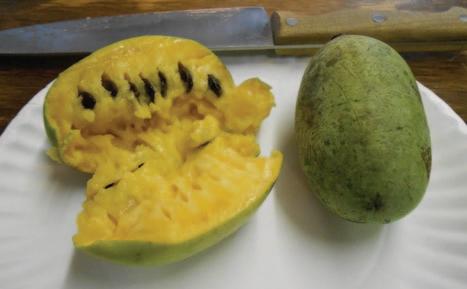


White grubs are turf pests found throughout N.C. They have cream colored bodies with yellow to brownish heads, six legs, are usually found lying in a “C” shaped position and are 1/4 to 1/2 inches in length. White grubs are the larvae form of several types of beetles, the most important and destructive of which is the Japanese beetle. White grubs have a one year life cycle, ten months of that being spent underground. The female Japanese beetle burrows into the soil in late June and lays her eggs. The eggs hatch in mid to late July. The young grubs move up in early August and begin feeding on grass roots severely damaging the root system. Feeding continues until cool weather arrives in October at which time the grubs move deeper into the soil in preparation for winter. As the weather warms in March, the grubs return to the root zone to resume feeding now, however, as full size adults. The larvae pupate in late May and emerge as beetles in early June.
Birds, moles, skunks and racoons all enjoy feeding on grubs to some extent. The presence of those animals and perhaps unexplained brown patches of grass serve as indicators of grub problems. All grasses are susceptible and can be destroyed by an unchecked grub infestation. Animals rooting or burrowing in search of grubs can cause further problems. You can check for grubs by peeling back on square foot sections of turf over several areas of your lawn. Cut down about three to four inches and examine the root zone area. If you average five or more grubs per sample, treatment is recommended. Grubs are easily controlled with pesticides but timing is critical. There are various choices of pesticides to attack grubs, the timing of which also varies. See us at LTD for your most economical option.








Books and Brew is a coffee shop and book store located at 2909 Nebo Road in East Bend, NC. A quaint little shop with a great deal of history and personality, it offers books clubs, Bible studies, teen chat time, art classes and much more. Drop by for a visit. Meet a friend for coffee. We serve all types of coffee, tea, pastries, LOTUS drinks, sparkling lemonade and great choices for the kids. We promise you will want to come back often. And bring the kids or grandkids to visit our Kid’s Table. They might even take home a free book. Watch for our special events all summer!! Flyers will be available in our store each week.

Combination 2909 Nebo Road (Wiseman’s Crossroads) East Bend, NC 27018 • 336-699-6142 Monday-Friday 7am to 4pm



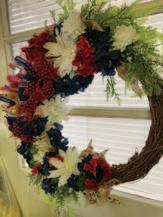




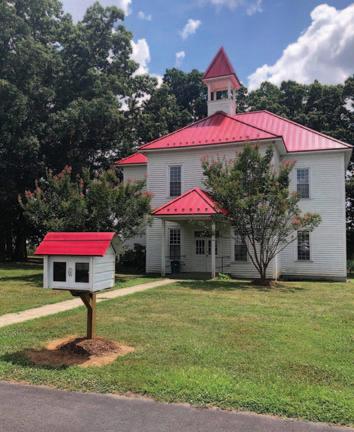
The bucolic Windsor’s Crossroads community is nestled in the southwest corner of Yadkin County. At the intersection of Buck Shoals Road, Windsor Road, and Hunting Creek Church Road stands the community landmark. Built in 1916, the two story white clapboard building with its cherry red roof, first served as a school until the community schools were consolidated in the 1930’s. In 1936, a chapter of the National Grange was started, and the one time school house became the meeting place for the Grange. For many years, the Grange provided programs and projects for the entire community. Today the iconic community building is home to Windsor’s Crossroads
Ruritan, a service club that was chartered in April 1988. Windsor’s Crossroads Ruritan Club is dedicated to improving the community by providing events each month. One of the most popular events occurs on the third Saturday in August.
The 20th annual Tractor Cruise begins with a hearty breakfast that will rival Shatley Springs. People come from far and near to inspect classic antique tractors parked on the grounds. Many people travel from 50 miles away to bring their tractors that have been restored to their original condition. In the past, there have been tractors brought from Virginia to attend this big event. At 10:00AM, the farmers start their tractors and form a caravan to begin their twenty mile cruise through the rolling countryside. It’s not unusual for a tractor to be pulling a wagon filled with passengers, young and old, sitting on benches or chairs or maybe even a golf cart. The colorful parade of John Deere green, Allis-Chalmer orange, Ford blue, and Case International red ends where it began. The local
farmers drive their prized tractors home while others carefully and lovingly load their classics onto trailers to be taken back to their shelters. Everyone leaves with a smile, a full tummy, and thoughts of next year’s tractor show and cruise. Events are planned monthly to fellowship with community members. A calendar of these events is created and mailed to keep everyone informed. In September, the club will be cooking BBQ Chicken. The plates include a half of chicken, baked beans, slaw, roll and homemade desserts. Cars start lining up early so they won’t miss out on getting a plate. In October, the club cooks Boston Butts. These are pre-sale only. Contact a club member to purchase one. Also, available for purchase is the club’s homemade secret BBQ sauce. In November, a country breakfast is planned. Through the generous support of the community, the club is able to help meet the needs as they arise in the area. Recently the club unveiled a Veteran’s Memorial to honor com-

munity members who have served in the military. The monument was dedicated in memory of one of its founding members, Stephen Tulbert. Annually, the club awards three scholarships to high school seniors who meet the criteria established by the club. The Leon Thomasson Memorial Scholarship was established to honor one of the founding members of the club. Leon Thomasson was a prominent member of our community and Yadkin County. The Kent Cranfill Vocational Scholarship is awarded to a senior who is pursuing a degree in a vocational area. Kent was an active member of the club until his death in 2016. Kent was known as a jack of all trades who strongly believed in vocational education. The Ruritan National Scholarship is awarded to a senior going to the local community college to further their education. Ruritan National will price match this scholarship.
The Windsor’s Crossroads community has grown in popularity in the last several years with the addition of wineries, wedding venues, bicyclists using the rural roads, and the Shiloh General Store. As you are driving through the area to one of these destinations, look for the red roof landmark building and you just might be fortunate enough to catch the Windsor’s Crossroads Ruritan Club having one of their many events throughout the year.


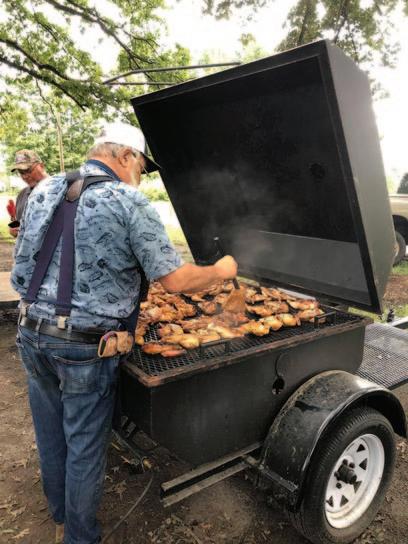
August 17
September 14
October 12
November 9
Breakfast and Tractor Cruise
BBQ Chicken Plates
Boston Butts Sale (preorder only)
Breakfast
Except for the Boston Butts Sale, events are first come, first served. Proceeds support scholarships and other community programs.
Whether you’ve had a whiplash injury, took a fall, or just overdid it at the gym, let us help you heal naturally!
These types of injuries involve your soft tissue, which consists of nerves, muscles, tendons, ligaments and cartilage. Unlike broken bones, soft tissue injuries can take years to heal.
It doesn’t take much to “throw” your spine out of align- ment and cause tissue tears, irritation, inflammation and scar tissue. When ignored,this can lead to altered biomechanics, spinal degeneration and disabling osteoarthritis.
Chiropractic care can improve your joint range of mo- tion and break up scar tissue, increase your circulation and reduce inflammation for a faster more complete healing. A Chiropractic adjustment is a controlled motion that can restore the alignment and function of your spine. The Open Rehabilitation Journal states controlled motion “can stimulate the repair and restoration of function.” Start functioning again with Chiropractic care!
You’ll want to spend as much time planning to feel healthy, as you would spend on your spring travel plans! There’s nothing worse than being on vacation and getting a flare up of severe back, leg, neck or shoulder pain. If you start your treatment now, we can change all that!
We see patients every day that come in struggling to walk, lift or turn their heads. Yet, after completing their program of Chiropractic care they have returned to their normal activities.
Don’t suffer needlessly from misaligned, injured and inflexible spinal joints. Spinal adjustments effectively reduce pain and enhance health... without drugs or surgery!
Let us help you and the people you care about live healthier and more active lives. CALL NOW!











Largest

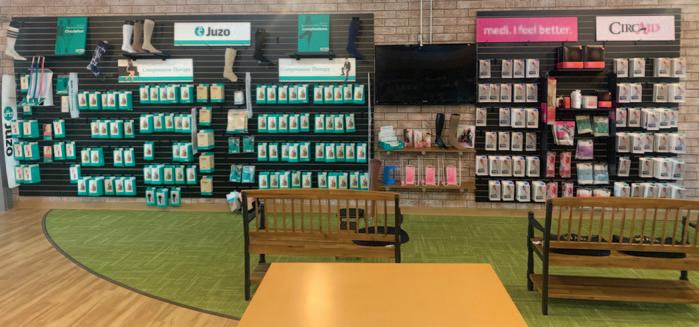
Offering Medical Supplies and Equipment
Bathroom Aids & Safety
Sanitation and Deodorizers
Beds & Accessories
Braces, Splints & Slings
Custom Fit Compression Garments
Daily Living Aids
Health Monitors
Mobility Aids & Equipment
Occupational & Physical Therapy Aids
Surgical Supplies Just
Manual Wheelchairs Hospital Beds
Electric Scooters Knee Walkers Lift Chairs
Hospital Medical Supplies
Home Medical Equipment
Discount Medical Supplies
Wound Care Products
Gloves, Nebulizer, Bariatric Equipment
Bathroom Safety Aids, Orthopedic Products, Ostomy Supplies
Respiratory, Urological/Catheters
Walking Aids & Wheelchairs
If you live in an area with a high deer population, you know the heartbreak of seeing your carefully tended garden transformed into a deer buffet overnight. At Mitchell's Nursery, we understand how frustrating it is to put time and effort into cultivating a beautiful landscape, only to have it ravaged by these persistent grazers. That's why we've compiled this guide to help you create a stunning garden that's resilient to deer damage. Our list of deerresistant shrubs and flowers will help you achieve a beautiful, vibrant landscape without constant worry.
Deer are creatures of habit, with distinct preferences when it comes to food. They tend to steer clear of plants with strong scents, fuzzy textures, or prickly surfaces. This gives gardeners a strategic advantage in selecting plants that deer generally avoid. Below are some top choices for deer-resistant shrubs and flowers that can help you maintain a gorgeous garden, even in regions with high deer activity.
Caryopteris (Bluebeard)
Caryopteris, commonly known as Bluebeard, is a lowmaintenance shrub that brightens up any garden with its vibrant blue flowers. Blooming in late summer and early fall, it's a favorite among pollinators, attracting bees and butterflies. The aromatic foliage, a key reason why deer tend to avoid it, also adds a pleasant fragrance to your garden. Caryopteris is a reliable addition to any garden, providing color and texture without inviting unwanted deer attention.
Forsythia
Forsythia is a cheerful early-blooming shrub that announces the arrival of spring with a burst of bright yellow flowers. While not particularly aromatic, its robust growth and dense branching make it unappealing to deer. This hardy shrub is excellent for creating hedges or borders and requires minimal maintenance, making it a practical choice for any garden.
Leucothoe
Leucothoe is a versatile evergreen shrub known for its glossy leaves and cascading branches. Its leathery texture and dense growth make it a deterrent to deer, while its year-round interest provides color in the fall and unique blooms in the spring. Leucothoe is a great choice for ground cover and adds depth to garden beds, ensuring a lush landscape without drawing deer.
Sarcococca (Sweetbox)
Sarcococca, or Sweetbox, is an evergreen shrub with a delightful surprise—its flowers produce a sweet fragrance during the winter months. This strong scent repels deer while adding a lovely aroma to your garden. Its compact size and shade tolerance make it ideal for smaller gardens or areas with limited sunlight. Sarcococca is a perfect
addition to a deer-resistant landscape, providing beauty and fragrance without inviting deer damage.
In addition to these shrubs, consider incorporating other fragrant plants into your garden.
Lavender, lantana, and gardenias are known to deter deer with their strong aromas. Lavender not only repels deer but also provides a calming scent.

Gardenias offer a rich, sweet fragrance, while lantana adds vibrant color to any garden. These plants not only beautify your landscape but also help keep the deer at bay.
By carefully selecting deer-resistant shrubs and flowers, you can enjoy a beautiful garden without the constant worry of deer damage. There is a wide variety of plants suited for creating a deer-resistant landscape. Whether you're looking for colorful blooms, fragrant foliage, or evergreen shrubs, you'll find something that suits your garden's needs. With the right plant choices and a touch of planning, you can create a stunning garden that is both beautiful and resilient. Say goodbye to deer-related frustrations and hello to a thriving landscape!
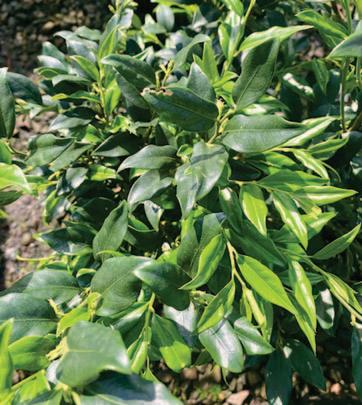







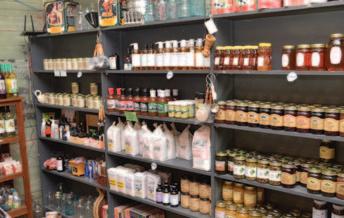







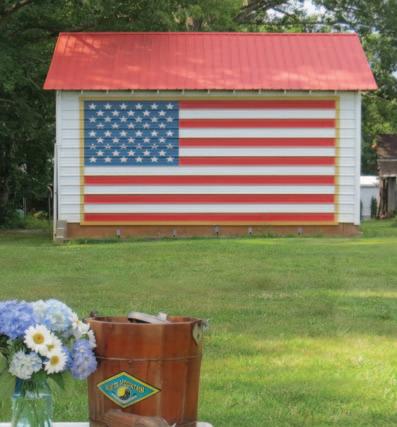
Many thanks to everyone who made this cover happen. My sister, Amber, who wants no credit but is willing to load up and haul a table and chairs across the county to help me out. Then she has to take pictures, too! Debbie, thanks for the loan of the ice cream freezer. I never imagined when I started asking around for a crank freezer that I would find one that was still in use!
When I mentioned the idea I had for a barn in the background with a flad on it, John Norman knew exactly where to send me. Mr. Porterfield graciously allowed me to set up on his property and take photos with his patriotic barn in the background. A veteran of the Vietnam War, he said that the national anthem still gives him chills. After buying the property, he and his daughter realized that there were exactly the right number of boards to paint for the stripes of the flag. Along with his wife, they hand painted Old Glory. The stars were traced individually by hand, and were quite tedious to complete. After a few years, the weather took its toll. The second flag to grace the barn is metal. Long may you wave!









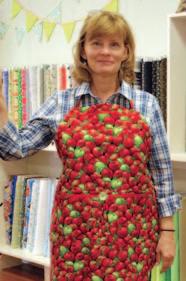



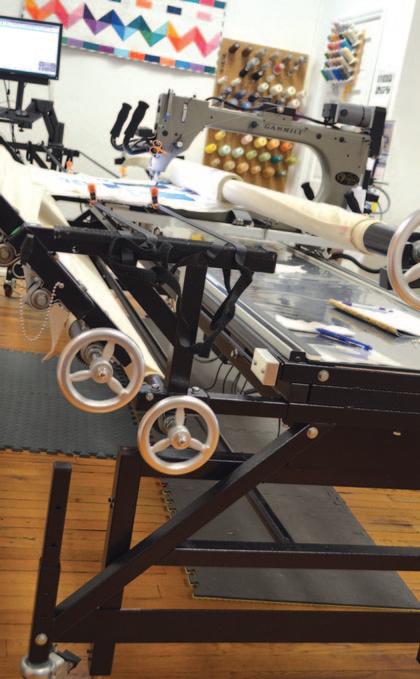
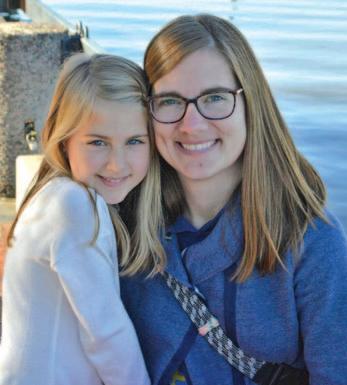
Director, Yadkin County Human Services Agency Medical Clinic and Wic jwall@yadkincountync.gov 336.849.7588

Summer time is some of the best weather and times to be doing activities outdoors. And there can be many hazards when we get out and about like water dangers or heat illness. This article is about a hazard that many might not see or think much about: tick-borne illnesses. Tick-borne illnesses are diseases that people can get from tick bites. These can be bacteria, viruses or even parasites.
It’s especially important to be thinking about ticks and protecting yourself from bites as early as possible. This means before you even head outside. Tick exposures can happen anytime, but there are more chances of having an exposure in warmer months because ticks are more active. Tick prevention includes keeping your skin covered as much as possible and
treating your clothing and items with products that contain 0.5% permethrin. According to the Center for Disease Control’s website dedicated to ticks, permethrin used to pre-treat your cloths or other items like boots will protect through several washings. Or, if you are planning a special trip or outing, you can purchase these items already treated. You can also look for EPA registered insect repellents and have “DEET, picaridin, IR3535, Oil of Lemon Eucalyptus (OLE), para-menthanediol (PMD), or 2-undecanone”. They go on to share that you should not “use products containing OLE or PMD on children under 3 years old”. It’s also important to think about where you are going to be and if that is a place ticks are prone to be. Ticks usually live in grassy or brushy areas. Or in wooded areas. You may even find them on your pets that go outside, which could bring them in to your home.
After you have been outdoors, especially in warmer months or when you have been in a potential tick area, you should check yourself and your clothing for ticks. Remove any ticks and wash or dry the clothing. Hot water for the wash or putting dry cloths in the dryer for 10 minutes will kill ticks. Don’t forget to check more than clothes. Check your bags, shoes, tents, coats and other items where ticks could be carried or transported. Check your body closely especially in crevices like under arms or behind ears and your scalp. These insects are going to look for places where they can tuck away. Think like a tick! The CDC also recommends showering soon after coming in. This could help reduce the risk of getting Lyme disease and may wash off ticks that aren’t attached. This is also a great time to check for ticks! You may also want to help reduce the amount of ticks in your yard with good routine law maintenance like keeping the grass cut and removing yard debris like leaf piles and brush.
What if you find a tick and it’s attached or you have been bitten? To remove a tick, use a set of fine-tipped tweezers to grasp the tick as close to your skin as you can. Pull up, steady and even. Be sure not to twist or jerk as this can cause parts of the tick to be left behind in the skin. If this does happen, use the tweezers to continue getting all the parts out. After removal, wash the area very well with soap and water or rubbing alcohol. The CDC shares that you never try to crush the tick with your fingers. They recommend disposing of the live tick “by putting it in alcohol, placing it in a sealed bag/container, wrapping it tightly in tape, or flushing it down the toilet”.
There are many types of diseases that can be transmitted by ticks, some of which are reportable by law to your local health department. North Carolina’s Communicable Disease Branch shares information about tick-borne illnesses on their website. According to the Branch, for later identification should you become ill, you can save the tick in a jar, plastic bag or tape it to an index card using clear tape. Make sure you write down the date the tick was removed. If you develop any flu-like symptoms over the next several weeks, see your doctor and let him/her know you were bitten”. These symptoms may include fever or chills, aches or pains or a rash. To be diagnosed with an illness from a tick bite, your doctor will likely do blood tests and look for abnormal results. Yale Medicine says these could be a white blood cell count or platelet count. Treatment for these conditions may be antibiotics or other medications.
Like many other public health messages preventing injury or illness, prevention is key! Be aware of where you are going and when and take precautions to avoid ticks and look for them after you have been outside. Don’t forget to check your pets and children also!










As temperatures heat up, the risk of heat exhaustion also rises. During these scorching months, it is important to know the signs and symptoms, as well as treatment for heat exhaustion. Heat exhaustion occurs after prolong exposure to high temperatures which cause the body to be unable to regulate its own temperature. This, in return, leads to dehydration and imbalance of electrolytes. If not treated, it could even lead to worsening health concerns of heat stroke and rhabdomyolysis which would require emergent care.
It's important to know the signs and symptoms of heat exhaustion. Signs and symptoms include:
•Heavy sweating
•Fatigue
• Weakness
• Dizziness

• Nausea or vomiting
• Headache
• Muscle cramping
• Rapid heart rate
• Cool, clammy skin
•Fainting or near-fainting If any of these symptoms occur, make sure to start treatment right away. First, staying hydrated is key. I’d recommend drinking at least 8 to
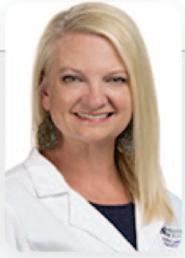
Ashley Lauer Family Nurse Practitioner Novant Health-Yadkin Medical Associates
16 oz of water every hour while outdoors in the heat. If you feel any symptoms starting, increase your water and add electrolyte replenishing drinks such as Gatorade. A good rule of thumb is to have at least 0.5-1 oz of water per your body weight up to a gallon (128 oz) of water to stay hydrated. This need increases when you are in the heat and if your activity level is increased. Avoiding drinking dehydrating liquids like alcohol and caffeinated drinks while in the heat. If you have any health conditions that restrict water intake, make sure to ask your healthcare provider before following these guidelines.
Second, take breaks from the sun. This includes limiting your outdoor activity during the hottest part of the day. Try to get out earlier in the morning or in the late evening to do outdoor chores. If you’re outside during the peak heat of the day, take breaks in the shade or in an airconditioned area.
Third, dress appropriately. Try to wear loose-fitting, lightweight clothing. Light color clothing is also better in the heat. Add a widebrimmed hat to help protect you from the sun.
Fourth, stay cool.
Using devices such as fans and cooling towels will help keep your body temperature regulated. If you feel symptoms are worsening, take a cool shower and apply ice packs to help bring your body temperature back down. Resting before going back in the heat is also essential. Lastly, know your limits. It’s always wise to listen to your body. Prevention is key. If you feel symptoms starting, stop to take a break from the sun, have some water and cool down. If you feel that your sweaty skin has turned cool or clammy, you need to get out of the heat immediately. Make sure someone is around to monitor for worsening symptoms.
If you have tried all treatment options and still having heat exhaustion symptoms, it is important to seek medical attention. You may need fluid and electrolyte replacement. Summer months are full of fun outdoor activities. Make sure you are monitoring for heat related illnesses while you are enjoying the sunshine. By following these simple, easy precautions you can stay safe and healthy while enjoying the summer heat.
If you want to go hiking in or near the Yadkin Valley, be sure you don’t overdo it and risk heat exhaustion. You can find easy and moderate trails, as well as some for more experienced hikers, at these state parks and recreation areas.
Hanging Rock State Park
Lake Norman State Park
Mount Jefferson State Recreation Area
New River State Park
Pilot Mountain State Park
Stone Mountain State Park


Did you know that kids are four times more likely to give back to their communities if they are involved in 4-H? This was found out through Tufts University’s research in 2012. That’s no surprise to us that have been in 4-H because we are all about giving back to our communities and even our world. It is an event in our 4-H Pledge that we “pledge our hands to larger service.” In 4-H, we teach youth ages 5 through 18 how important it is to give back to others. Whether that be giving back in seemingly small ways or on a grander scale, we want our youth to know the importance of giving back to others. Now you might be thinking, “They are just kids! I barely give back to my community so how exactly are kids supposed to do that?” That is a valid question. They are “just” kids after all. But in reality, it does not matter your age when you are trying to make an impact in your community; it’s your willingness to do so. And the possibilities are truly endless too on what they can do!

Madaline Jones

WRITER/PHOTOS
Madaline Jones 4-H Agent
Yadkin County madaline_jones@ncsu.edu
Our 4-H’ers have completed some really amazing projects over the years including writing letters. All this project costs you are time, a pencil, maybe some makers, and some inexpensive cards. Our youth have written thank you letters to our dedicated volunteers, they have written cards to those in our local nursing homes, and most recently they are writing cards to active duty military members for Christmas. How easy is it to just say thank you or draw a sweet picture? How amazing does it make you feel when you receive a card in the mail, too?
Writing is not for everyone though, so another way that kids can give back is through their time. Time is absolutely free and they just have to be willing to give it! This can be in the form of picking up leaves for an elderly neighbor, helping out younger kids learn a new task, doing a roadside litter pick up, or even sorting food at a local food bank. Food banks often need help. Our 4-H’ers use this as a form of volunteer hours for school. One of the special events that our local bank invites our 4-H’ers to every year is the Stamp Out Hunger Campaign where all residents of our county are asked to give non-perishables through our mailing carriers. When the mail carriers arrive with the food,
volunteers come to get it out of the vehicle and then sort it. These community service projects are both impactful and so meaningful to the ones receiving your time on this project.
Maybe your child does not have a lot of time to give to others due to prior engagements like sports, part time jobs, competitions, etc.. Therefore, giving actual items may be a better way to go. However, we all know that youth normally are not rolling in the dough; so how can they give back in this way? This brings me back to another example of what 4-H’ers in Yadkin County have done. This year, our 4-H’ers designed a book drive they called “Books for a Cause.” For this book drive, participants were asked to bring in gently used or new books for grades Pre-K through Fifth grade. These books would then be donated to new teachers in our county that did not have enough books for their classroom libraries. This donation drive allowed our kids to give books that they had already read and encouraged others to give as well. We ended up raising 350 books! So even if your child cannot give items that cost money, they have options. Many organizations also ask for donations of gently used coats or other articles of clothing. Another neat


way to give is through saving up tin drink tabs for Ronald McDonald House or plastic bottle caps to make a park bench. This way of giving is free and does great things for your community. Another way Yadkin County 4-H will be giving back to this community later this year will be through collecting socks for “Socktober.” For this cause, we are asking 4-H families to donate unused/new socks for a local charity. This cause is super simple, but still makes a big difference.
Regardless of how your kids choose to give back, make sure they do not only do it to benefit others, but also for themselves. The joy that we receive from giving back to others and either getting to see the happiness on their faces or knowing that they made a difference in their lives, is priceless. Yadkin County 4-H wants to challenge you during the holiday seasons to give back this holiday season. It is the season for giving after all. If this article sparked an interest in 4-H for you and you would like to know more about us, make sure to contact your local Cooperative Extension Office. Find the contact information for your local office at https://www.ces.ncsu.edu/. 4-H operates through N.C. Cooperative Extension, which is an equal opportunity provider, so we would like to invite all to join in on the fun we have within our program.






















Not everyone can see the love each person sends into the world.
Cat could.
One day, Cat and his friend Wren were sitting on the low stone wall that surrounded the fountain in Callaghan Park. Over in the playground, a mother was pushing her daughter in a swing. Seeing the sparkling colors of the love coming out of the mother made Cat smile.
“The love coming off people is always beautiful,” he said. “Today, the love coming off that mother strikes me as especially delightful.”
Wren was a gifted artist, and she often carried a sketchpad with her.
“Today is the day,” Wren said as she pulled her sketchpad out of her bag and opened it up. “Today, you and I are going to create a picture together. Please tell me what the love looks like.”
As Cat started talking about the cascading colors, Wren started sketching.
From time to time, Wren would look at Cat. Sometimes, he would just nod, and she would go back to drawing. Sometimes, he would scrunch his mouth a little. When he did that, Wren would know that she didn’t have it quite right. She would raise her eyebrows as a way of inviting him to offer suggestions. Cat might suggest that she do this. Or
he might suggest that she do that.
“It’s just like I am a police artist and you’re describing to me the criminal who got away,” Wren said.
“Well, not exactly,” Cat said. “If I were describing an escaped criminal to you, I think I might feel bad. I feel really good right now.”
When the girl was done swinging and hopped down, the mother took her daughter’s hand. They started walking toward Wren and Cat.
“They’re coming this way,” said Cat.
When the mother and daughter came up, the girl said, “I’m going to have a brother. He’s coming in two months.”
“Do you know what his name is going to be?” Cat asked.
The girl turned to her mother and said, “Do I?”
“Not yet,” her mother said and smiled.
“My name is Riley,” said the little girl.
“Nice to meet you, Riley,” said Wren. “My name is Wren, and this is Cat.”
Looking up at Riley’s mother, Wren said, “I was just drawing a picture of you while you were pushing Riley in the swing. You want to see it?”
“Absolutely,” said the mother.
Wren turned the pad around and held it out so the mother could take it. She did.
“What are the wispy colors coming off of me?” she said.
“I can see love,” Cat said, “and I was telling Wren what the love coming off you while you were pushing your daughter in the swing looked like. Wren is a really good artist.”
The mother’s lips formed a gentle smile.

“That’s what I look like when I’m pushing Riley in the swing?” she said to Cat.
“That’s what it looks like to me,” Cat said.
“You can have the picture,” Wren said.
“Thank you,” said the mother.
“After I make my wish and throw a penny into the fountain,” Riley said, “we’re going to get ice cream.”
After making her wish and tossing her penny, Riley said, “If I know what my brother’s name is going to be next time I see you, I will tell you.”
The mother took her daughter’s hand. They turned and began walking away. As they reached the edge of the park, the mother looked over her shoulder at Cat and Wren and smiled at them. When she turned back, she squeezed her daughter’s hand.

If you recognize Kim Underwood’s name, it’s probably because you read his articles in the “Winston-Salem Journal” during his 25 years there. Since leaving the Journal, he has also worked for the W-S/Forsyth County School System. Now retired, he has written “Cat and Wren” among other books for young readers. We hope that you enjoyed chapter 1!

1 cup half and half (whole milk will work if that is what you have, but it might not be as creamy)
1/2 teaspoon vanilla
1 tablespoon sugar
ice
1/4 cup salt
Ziploc bags 1 Small, 1 Large
Instructions
Pour 1 cup of half and half into a small ziploc bag.
Add vanilla and sugar.
Seal the bag firmly (get as much extra air out as you can first).
Yadkin Valley Kids is devoted to our younger readers (or those young at heart!). If you enjoyed reading about Cat and Wren, go to our website to print out a coloring sheet of the girl on the swing and her mother from the story. Maybe you can draw a picture showing the love sent out from someone you know? If your parents allow it, share your artwork on social media and tag us.
www.yadkinvalleymagazine.com/yadkinvalleykids
In the larger ziploc bag, fill it about 1/2 way with ice. Add the salt. Then add your small bag to the big one and fill with more ice on top. Seal the large bag. It will be cold, so either wear gloves or hold the bag in a towel. Shake for 6 minutes.
Take the small bag out of the large bag and rinse the outside of the small bag with cold water. Make sure to rinse out the top part of the bag also (above the seal). No one wants salt in their ice cream!
Carefully open the small bag. The ice cream will be a little icy looking to start. Use a spoon to mix it around and soften it u p a bit. Scoop out and enjoy!
You can always add fruit, chocolate syrup, or other toppings to your ice cream after shaking.


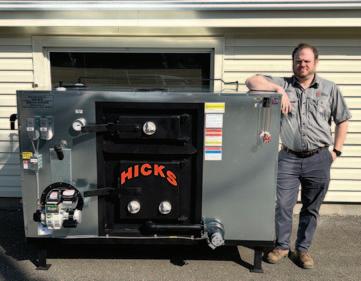


“Beautiful young people are accidents of nature, but beautiful old people are works of art.” – Eleanor Roosevelt
I usually hesitate to call anyone “old”. But at 105, I don’t think Carl Lyerly is offended.
Born on a cotton farm in Rowan County in 1918, Carl was one of ten children. He recalled walking two miles to the one room school he attended for eleven years. Carl also remembered his teacher’s name. I bet there are many people half his age who cannot do that. He said that a trip to Salisbury, the nearest town, took all day in a wagon pulled by a mule, so by the time he was 17 years old, he had only been “to town” two times. As a kid during the Depression, he said that nothing really changed for his family. They made do with the little they had, just like they always did.

With the permission of his parents, Carl enlisted in the Navy in 1936 when he was just 17 for a “minority tour”. He served on the Admiral’s Ship USS Indianapolis, the fastest ship in the fleet at the time, according to Carl. He told me about the 1936 trip to South America, when the
Indianapolis transported President Franklin D. Roosevelt on a “Good Neighbor” tour. Carl named the ports that the President visited: Rio de Janeiro, Buenos Aires, Montevideo and Port of Spain. It was the first time a serving U.S. President had travelled outside of North America. He taught me the term “shellback”. When a sailor crosses the equator for the first time, they are initiated as a shellback. Along with other sailors, Carl and President Roosevelt participated in the initiation, and the President autographed Carl’s Shellback Certificate. Unfortunately, a long ago fire destroyed the certificate and other memorabilia from Carl’s Navy days. Aboard the USS Indianapolis, Carl made many other incredible memories. The farm boy from North Carolina, who only “went to town” twice before he joined the Navy, rode the Ferris Wheel and roller coaster at Coney Island. In 1937, along with other sailors as well as civilian pedestrians, he marched across the Golden Gate Bridge at the celebration of its opening. In addition to South America, he visited Europe, Asia and many places in the South Pacific. I asked what he thought was the most interesting place he visited, and without hesitation, he said the Galapagos Islands, and said he would go back there if he could.
Carl left the Navy in 1939, at age 21, before the United States entered World War II. With few jobs available, he took a course in air conditioning and refrigeration and worked for General Electric. Before World War II ended, Carl would be drafted and served two more years in the Navy. After many jobs, from Buffalo to San Jose, from a cotton mill to selling sheet music, Carl’s friend Grady
convinced him to sell Townecraft cookware. Going into customers’ homes, he would demonstrate the cookware, and if other couples attended, the hostess would receive a free electric griddle. Carl got very interested in nutrition during that time, and credits his eating habits for his good health and long life. He is very deliberate about what he puts into his body, and takes supplements as he believes that our food is less nutritious than it used to be.

Besides working at the same job, he and Grady would go on to marry sisters. Carl and Dot had two sons and two daughters. He told me that all total, he has 45 grand, greatgrand, and great-great-grandchildren. Some live pretty close to his current home in Iredell County, but one grandchild and family live as far away as Germany.
I only spent a couple of hours with Mr. Lyerly, but I can only imagine the stories he would tell given more time. His memory is incredible, as he recalled details about his childhood
like the mile-long fence his father built that was as “straight as an arrow”. He remembered driving before there was such a thing as a driver’s license. He said that the ruts in the road were so deep from wagons that a Model T didn’t have to be steered. Before joining the Navy, he said he never had more than 25 cents to his name. I’m sure the thirty dollars a month pay in the Navy felt like a fortune. He remembers the first time he used a telephone, on a party line, no less.
But by no means has he stopped making memories. In spite of surgery when he was 100 to repair a broken hip, Carl walks unaided at 105. A couple of years ago, he hiked in the Linville Gorge area. Last year, he met Richard and Kyle Petty. Reading has become difficult, so he is eagerly awaiting a device to enlarge print so he can read again, hopefully he will have it in time to read this article, and the birthday cards he is sure to receive when he turns 106 later this summer!
Carl Lyerly, thank you for sharing your story with me and Yadkin Valley Magazine readers. Happy Birthday a little early!
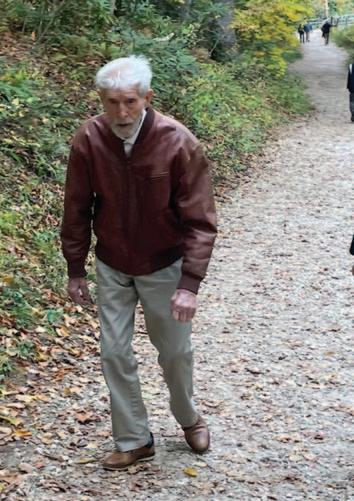
In 1945, the USS Indianapolis would carry uranium and other atomic bomb components to the Pacific. After making that historic delivery, the ship was torpedoed and sank. Of the nearly 1,200 on board, only 316 survived, making it the greatest loss of life from a single USN ship in history. At the time of this writing, the official USS Indianapolis website lists only one survivor of the sinking who is still living. As for those who served aboard her prior to the sinking, I imagine there are none other than Carl Lyerly.



Just a block away from the activity of Main Street Sparta you will find a “laid back” atmosphere to retreat, relax, and refresh on your mountain daytrip.
Schedule some holistic self-care at Sprinkles Salt of the Earth, 304 Jones Street. Book a session in the salt cave and add ionic foot detox, infrared sauna, or lymphatic massage. Plus, find a curated selection of support products for your health journey.
Take a break and settle into the intimate setting of the Cellar on Evergreen. Accessible from a
Main Street walkway or behind Main at 40 Evergreen Drive. Offering appetizers, charcuterie, and often a bit of music to accompany their selection of tea, wine, and beers.
A warm hello greets you at the Gathering Place Coffee Shop at 81 W. Doughton Street. Serving a variety of coffee drinks and tempting pastries, roam the gift shop that includes many locally made items, or find a table at the outdoor bistro area. And, they have a drive thru!

Barb, (Babs) Collins is a happily retired writer and marketing professional. She loves mountaintop life and introducing authors to the region through book events like the Writers Road Show Author Tour, sponsored by the Northwestern Regional Library System.
For a scenic drive, you can never go wrong with the Blue Ridge Parkway. But check out some other scenic drives in or near the Yadkin Valley. You can find information about them at https://www.ncdot.gov/travel-maps
Yadkin Valley Scenic Byway
Sauratown Mountains Scenic Byway
Upper Yadkin Way
Big Horse Creek Byway
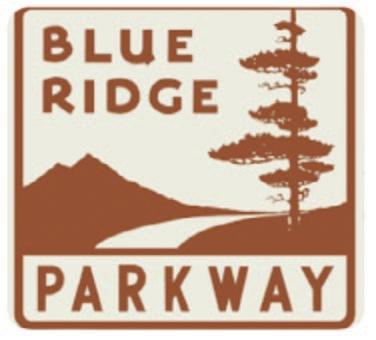


The next two correct entries drawn win a copy our One Last Sweet Bite Cookbook.
Enter by postcard, letter or email, be sure to include your: name, PHYSICAL MAILING ADDRESS and guess. And if you’d like, tell us about your experiences using or collecting this item. Entries must be received no later than 8/16/24, Winner will be drawn 8/17/24. The winners will be notified by mail and announced in the September-October 2024 issue. All entries become the property of Yadkin Valley Magazine. Turn to page 76 to read about the May-June contest.

Mail your guess to: “What is That Contest” Yadkin Valley Magazine PO Box 2077 • Yadkinville, NC 27055 or e-mail: yadkinvalleymagazine@gmail.com. You can also enter on-line at: yadkinvalleymagazine.com


Bulova • Hermle
Howard Miller
Why should you buy your new Grandfather Clock from Oldtown Clock Shop & Repair?
Our clocks are under factory warranty and we do the warranty work
We deliver your new clock for FREE
We “set up” your clock in your home or business
We offer a full service department
And even after offering all those extras that others don’t…
Our prices are very competitive!
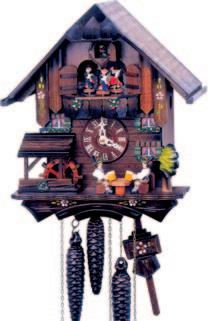


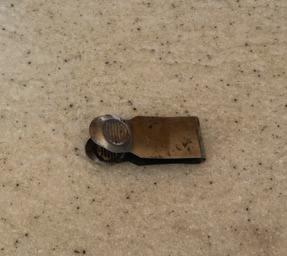
The May/June What IS That? item was correctly identified by only a few people. It is a strawberry capper or huller. Some of you even gave the brand name of yours, Spee-Dee. This one is my moms, and although she has had it for a long time, they are still made and available to buy new. Colean Lovette of Wilkesboro was the first correct answer drawn, and will receive $100. She commented in her entry that a friend gave it to her, and she had just used it to take the caps off of some strawberries. Marcia Phillips of Mocksville and Sally Kaspar of Clemmons will each receive a copy of One Last Sweet Bite, a Yadkin Valley Magazine cookbook. Their correct answers were the next two drawn.
Please be sure to include your name and physical mailing address with your entries. You cannot be the winner if I don’t know how to send a prize to you!




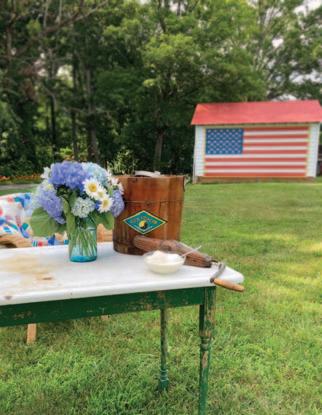
If you know someone who has recently celebrated this milestone birthday, Yadkin Valley Magazine would love to recognize them. Send in their name and a photo by August 1 to see them in the September/October issue. Photos mailed in will not be returned, so please send a copy.
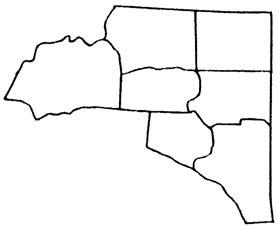

You can’t predict financial emergencies — but you can prepare for them.
To do that, you can build an emergency fund to pay for unexpected expenses, some of which may be sizable. Without one, you might be forced to dip into your investments, possibly including your retirement accounts, such as your IRA or 401(k). If this happens, you might have to pay taxes and penalties, and you’d be withdrawing dollars that could otherwise be growing over time to help pay for your retirement.
In thinking about such a fund, consider these questions: How much should I save? The size of your emergency fund should be based on several factors, including your income, your spouse’s income and your cost of living. However, for most people in their working years, three to six months of total expenses is adequate. Once you’re retired, though, you may want to keep up to a year’s worth of expenses in your emergency fund — because you don’t want to be forced to cash out investments when their price may be down, and you may not be replenishing these accounts any longer.
How can I build an emergency fund? Given all your normal expenses — mortgage, utilities, food, transportation and others — you might find it challenging to set aside some extra money in an emergency fund. But you do have opportunities. If you’re working, you could set up a direct deposit so that part of your paycheck goes directly into your emergency fund. You could also save a portion of any extra income you receive, such as bonuses and tax refunds.
Where should I keep the money? An emergency fund has two key requirements: You need to be able to access the money immediately and you need to count on a certain
amount being available. So, it’s a good idea to keep your emergency fund in a liquid, low-risk account that offers protection of principal. For this fund, you’re less interested in growth than you are in stability. But because interest rates have recently changed, you may be able to get a reasonable return without sacrificing liquidity or safety. What types of emergencies should I prepare for? Your emergency fund could be needed for any number of events: a job loss or early retirement, housing or auto repairs, unreimbursed medical bills, unexpected travel, and so on. But this fund may also be needed to help you cope with other threats. Consider this: In 2023, the U.S. saw a record 28 weather and climate disasters, each of which resulted in at least $1 billion in damages — and often many times this amount — according to the National Oceanic and Atmospheric Administration. Depending on where you live, your home or business may be susceptible to tornadoes, floods, wildfires, hurricanes and extreme heat and cold waves. These events can, and do, result in property repair and relocation costs, higher insurance premiums and even price increases for basic goods, such as groceries and prescription medications. One final word about an emergency fund: It takes discipline to maintain it and to avoid tapping into it for everyday expenses or impulse purchases. The name says it all — this is a fund that should only be used for emergencies. By keeping it intact until it’s truly needed, you can help yourself weather many of the storms that may come your way.
This article was written by Edward Jones for use by your local Edward Jones Financial Advisor. Edward Jones, Member SIPC

Draughn, Mike Russell, Kody Easter, Tammy
Not pictured: Randy Joyce, Nathan
Aaron L. Misenheimer, CFP®, ChFC®
Randy D. Joyce
Financial Advisor
Paul J. Bunke, Sr., AAMS™, CFP®
Financial Advisor
124 W. Kapp Street, Suite C PO Box 407 Dobson, NC 27017
336-386-0846
paul.bunke@edwardjones.com
Audra Cox
Financial Advisor
715 S Main St, Suite B Dobson, NC 27017
336-569-7385 • 844-795-3462 audra.cox@edwardjones.com
Frank H. Beals
Financial Advisor
965 North Bridge Street Elkin, NC 28621
336-835-4411
frank.beals@edwardjones.com
Barry Revis, AAMS™ Financial Advisor
116 E. Market St., Elkin, NC 28621
336-835-1124
barry.revis@edwardjones.com
Nathan Sturgill
Financial Advisor
116 E Market Street Elkin, NC 28621
336-835-1124
nathan.sturgill@edwardjones.com
Financial Advisor
1530 NC Hwy 67, Suite A
Jonesville, NC 28642
336-258-2821
aaron.misenheimer@edwardjones.com
Andi Draughn Schnuck
Financial Advisor
496 N. Main Street
Mount Airy, NC 27030
336-789-1707
andi.schnuck@edwardjones.com
Dale Draughn, AAMS™
Financial Advisor
140 Franklin Street Mount Airy, NC 27030
336-789-0136
dale.draughn@edwardjones.com
Logan Draughn
Financial Advisor
492 N. Main Street Mount Airy, NC 27030
336-789-3323
logan.draughn@edwardjones.com
Kody Easter, AAMS™, CRPC™, CFP®
Financial Advisor
304 East Independence Blvd
Mount Airy, NC 27030
336-789-2079
kody.easter@edwardjones.com

136 W. Lebanon Street Mount Airy, NC 27030 336-789-6238
randy.joyce@edwardjones.com
Tammy H. Joyce, AAMS™
Financial Advisor
136 W. Lebanon Street, Mount Airy, NC 27030
336-789-6238
tammy.joyce@edwardjones.com
Tanner Joyce
Financial Advisor
752 S. Andy Griffith Pkwy, Suite 400 Mount Airy, NC 27030
336-245-9112
tanner.joyce@edwardjones.com
Mike Russell
Financial Advisor
106-B South Depot Street, Pilot Mountain, NC 27041
336-368-2575
mike.t.russell@edwardjones.com
Michael Warren
Financial Advisor
101-D Shoals Road, Pilot Mountain, NC 27041 336-368-0782
michael.warren@edwardjones.com
Christopher L. Funk
Financial Advisor
128 South State Street • PO Box 790 Yadkinville, NC 27055 • 336-679-2192
chris.funk@edwardjones.com




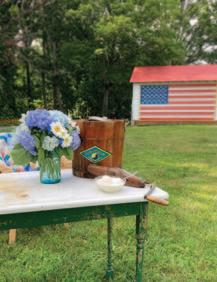



There once was a man who awoke every morning to a beautiful sight. The cottages on the other side of the valley glowed like a campfire. He surmised that those cottages must be made of gold in order to glow so brightly every morning. He thought every day about how much better it would be to live in a cottage made of gold. One day, his desire for a golden cottage overcame his good sense. He decided that he no longer wanted to live in his regular cottage but wanted to live in a golden cottage instead. He packed all his belongings and started the long walk to the other side of the valley. When he arrived, he was disappointed. These cottages looked just like his own cottage. They were not made of gold, just mud and wood. It was getting late in the day, he was exhausted from both his long walk and his disappointment. The sun was starting to set. He looked longing across the valley to his own cottage. He was shocked at what he saw. His own cottage was glowing in the sun’s setting rays. It looked like it was made of gold. He realized that he was searching for what he already had. The next morning he walked back home content with his life.
There are no shortages of businesses trying to sell us forms of golden cottages: “Buy a new car and get the good life.” “Buy your dream home and get the good life.” “Come
to our gym to get the body you deserve and get the good life.” This wasn’t the good life that Jesus promised us in John 10:10 when he said, “I came that they may have life, and have it abundantly.” Jesus was not promising us a new car, a new house, or the perfect body. He was talking about something that was much more important.
The word for life in Greek is Zoe. Zoe is used 275 times in the New Testament including in John 10:10. It means absolute life, fullness of life, life that is real and genuine. Jesus came so that we may have Zoe and have it abundantly.
This is what Jesus wants for us. Not just that we have a pulse, but that we have an abundant life in him. The first step in finding the good life is not to follow the traveler in search of the golden house. The first step is to find contentment in what we have today. It is in gratitude that we start to discover the good life. Jesus says it best when he said, “Are you tired? Worn out? Burned out on religion? Come to me. Get away with me and you’ll recover your life. I’ll show you how to take a real rest. Walk with me and work with me—watch how I do it. Learn the unforced rhythms of grace. I won’t lay anything heavy or ill-fitting on you. Keep company with me and you’ll learn to live freely and lightly.” Matthew 11:28 (MSG) My wish is that we can all find this life and find it abundantly.

Rev. Dr. Heather Kilbourne spends her days helping rural churches dream God-sized dreams for their communities. She is the founder and Director of Faith in Rural Communities at the NC Rural Center. She is an ordained minister in the United Methodist Church and served churches in Yadkin and Burke Counties. She can be reached at hkilbourne@ncruralcenter.org.
Care South, Inc. is a locally owned and respected agency that has provided more than 20 years of In-Home Aide Care to individuals who require assistance with Activities of Daily Living (ADLs).
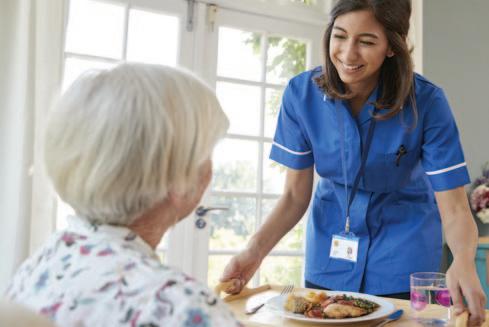


To inquire about services for you or a family member or employment opportunities for:
In-Home Aides, Certified Nursing Assistants (C.N.A), and Personal Care Assistants (P.C.A), please contact us at:
Mission
To deliver exceptional Personal Care Services (PCS), allowing the client to live safely and comfortably in their own home and to provide leadership in which employees have faith and confidence.
What Programs are Provided through the Agency?
• Community Alternative Program for adults (CAP/DA)
• Personal Care Services (PCS)
• Veterans Administration (VA)
• Temporary or Long-term Care
• Chore Respite
• Private pay
Summary of the Service Provided:
• Activities of Daily Living (ADLs) (i.e., eating, bathing, dressing, toileting, mobility, and grooming)
• Instrumental Activities of Daily Living (iADLs) (i.e., light housekeeping, meal prep)
Practices and Staff:
• Licensed and bonded in North Carolina.
• RN Supervisor conducts quarterly visits to the home.
• CPR Instructor
• Staffing Coordinators provide 24/7 On-Call Services.
• Caregivers complete monthly in-services, maintain C.P.R., and perform skills competency verification by the R.N.
• Comprehensive background investigation of all caregivers (i.e., criminal background)
• Quality Assurance Program













